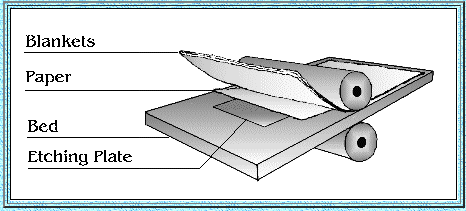What Is Etching?
Etching is a traditional way to make multiple prints from one drawing effort. For that reason, it is the process of making prints from a metal plate (generally copper, zinc or steel). Furthermore, each plate has a design which has been incised by acid. A thin ground (a waxy material) is rolled onto a heated metal plate to protect it from the acid and lines are drawn into the wax ground, exposing the metal to the acid. Great care is taken in how long the plate is left in acid; the lines that are desired darker are left in the acid bath longer and the lighter lines are exposed for less time. This means the artist must remove the plate from the bath, protect those lighter lines with wax ground, and return the plate to the bath for the darker lines to continue to etch.
Once satisfied, you remove the plate from the bath, rinsed and with the ground removed. To remove the ground, mix up a paste comprised of ammonia, lemon juice or vinegar, and whiting. Using a soft cloth like muslin, gently remove the ground with a circular motion. Therefore, this process will also polish the plate. Using this paste to clean the plate is good practice even before a ground is laid. This will ensure the acid will ‘bite’ a clean line in the metal.
Printing Process
Next, apply etching to the plate and wipe it down so that generally the only ink that remains is in the etched lines. These lines hold the ink. Lay a moist piece of paper on top of the plate, covered with three or four felt blankets and run it through the etching press under tremendous pressure. The paper receives the ink from the etched lines and you will have a perfect mirror-image of your drawing. Allow the print to dry by hanging it up on a line and your etching will be complete.
The artist decides how many prints will be part of his/her edition, and each print is repeated as above. Keeping each print in the order it was printed, the artist signs and numbers each print in pencil. For example, if the edition consisted of 30 prints, the fifth print would be identified as 5/30. The more limited the prints in each edition, the more valuable each print is. Traditionally, the artist is allowed to make 10 artist’s proofs in each edition for his own use. They are marked A/P for artist’s proof. Consequently, after the edition is complete, the plate is destroyed by using the stylus to mark an “X” through the plate, rendering it useless for further prints. And the collectors are confident that no more can be made from the plate. Above all, from a collector’s perspective, Artist’s Proofs are valued even more highly than the numbered prints.
In conclusion, many feel Rembrandt is one of the greatest etchers of all time. His exploration of composition through this medium is unparalleled. Whistler was also one of the most notable of etchers in art history for his natural ‘calligraphic’ line that was perfectly suited to this artistic expression.






Leave a Reply
You must be logged in to post a comment.